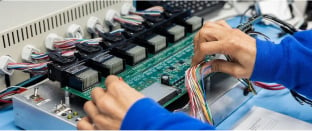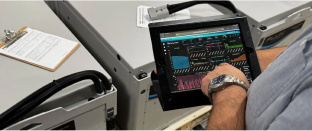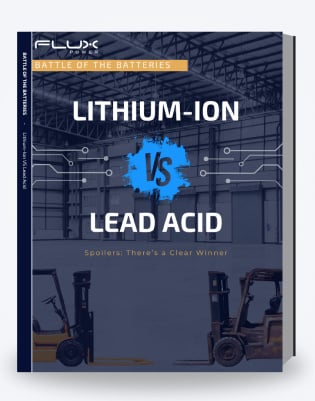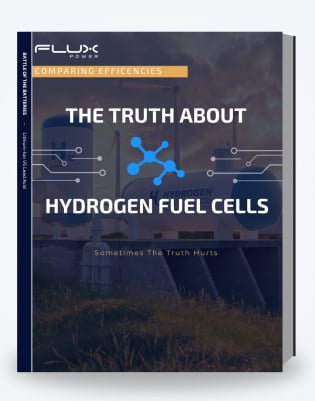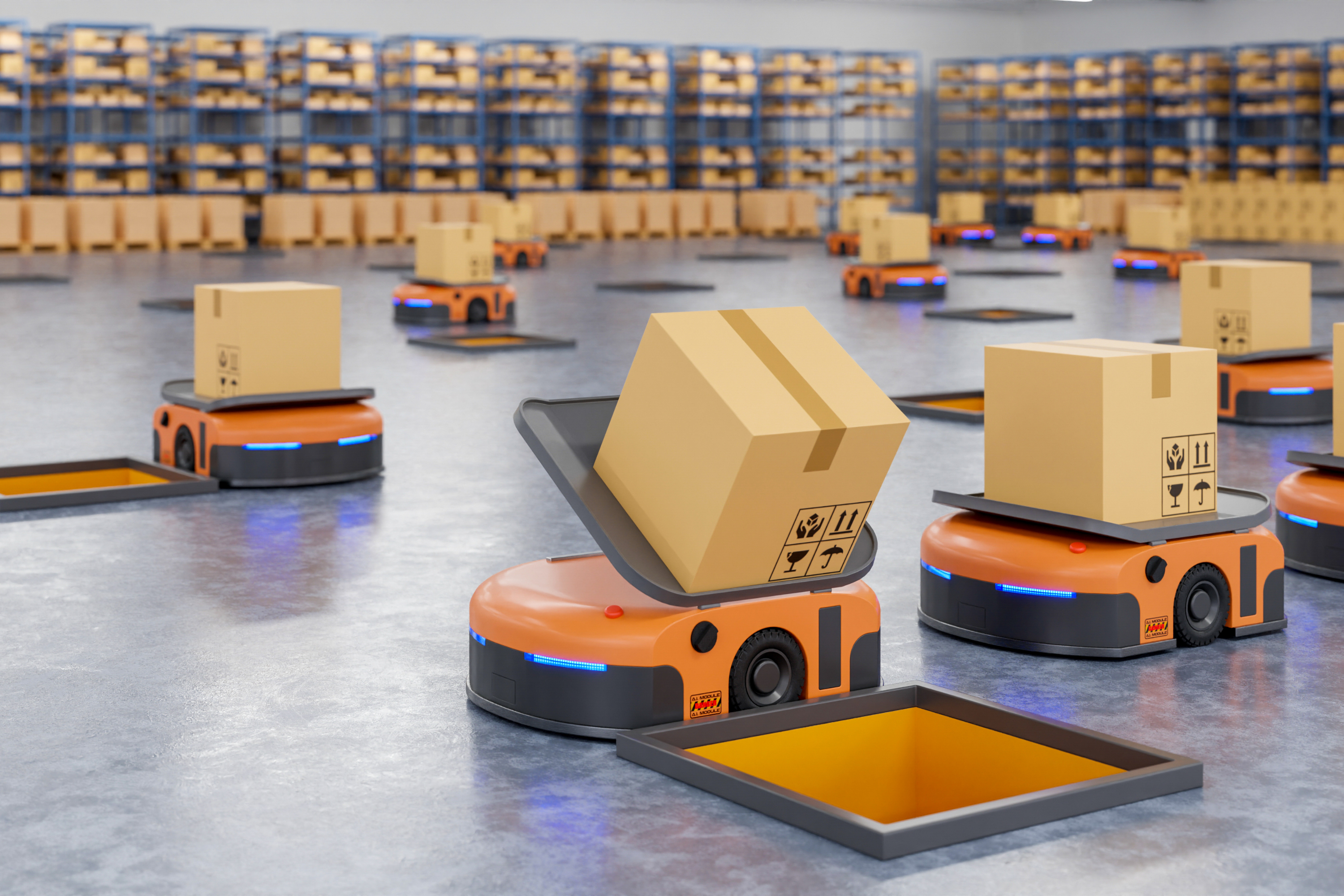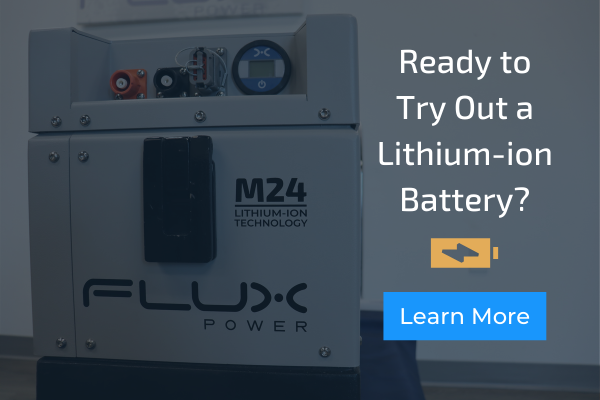Warehouse Automation
The boom in online retail sales has led to a huge uptick in the growth of distribution centers, especially after the Covid-19 pandemic.
Many warehouses are working to improve productivity and increase their output to keep up with increasing e-commerce demands. At the same time, some facilities are struggling to fill entry-level warehouse positions, with higher labor costs, higher demand for employees, and tighter regulations.
Warehouse managers are looking to automation as a cost-effective way to increase their output and free up human workers for more complex tasks.
There are many different types of automated solutions that warehouses might use for different applications, including:
- Automated storage and retrieval solutions (AS/RS)
- Conveyor systems
- Autonomous mobile robots (AMRs)
- Automated guided vehicles (AGVs)
The type of battery used to power AGVs is crucial to making the investment pay off. Lithium-ion batteries deliver much greater productivity due to their low maintenance requirements and larger capacity.
In this blog, we will explore the current state of AGVs in the material handling industry and discuss why choosing a lithium-ion battery AGV over a lead acid battery AGV is important for reaching your productivity goals. In addition to AGVs and AMRs, other industrial equipment like aerial lifts and floor cleaners are also increasingly relying on lithium-ion power for optimal performance.
What is an Automated Guided Vehicle?
AGVs have been around since the 1950s as a solution for moving heavy materials around large industrial buildings.
The term AGV can apply to multiple types of vehicles, including carts, tuggers, forklifts, or unit load vehicles, and they are usually battery-powered.
Traditionally, AGVs were able to navigate through buildings by following marked lines on the floor, using wires that transmit radio signals or guide tape that the AGV follows with sensors.
The use of AGVs allows for warehouses to control costs and reduce unpredictability in material handling that need things moving at peak efficiency.
The fact that their path, acceleration, and deceleration can be controlled to maintain consistent, safe movement, along with automatic obstacle detection bumpers, makes AGVs safe in any work area.
What are Autonomous Mobile Robots?
Autonomous mobile robots, or AMRs, have stolen the spotlight more recently as a flexible option for e-commerce order picking. The key difference between the two is that AMRs can move through their environment without having to follow a predetermined path.
The AMR can find the most efficient route through the warehouse and can work collaboratively with human operators. Due to their flexibility, they are typically used in tasks related to e-commerce, in sortation, and goods-to-person order picking.
While AMRs dominate the e-commerce area, AGVs still have their place as a proven, reliable solution for moving larger loads within industrial facilities. However, the lines between these two distinctions and the functions they perform can also be somewhat blurred. Some AMRs are capable of moving larger loads, and some AGVs are being used for goods-to-person order picking.
Recent developments in AGV navigation technology allow their routes to be easily changed using software, rather than re-installing wire embedded in the floor.
Additionally, AGVs have built a reputation for being precise and consistent, which is attractive for operations with narrow aisles or limited space for material movement routes.
Both technologies have their own applications where they work best.
Why Pair Lithium-ion Batteries with AGVs/AMRs
For operations trying to keep things moving 24 hours a day, having to stop to change out heavy lead acid batteries for charging is a huge time waster.
When companies choose to invest in AGVs or AMRs, they are focused on improving
- Productivity in warehouses
- Reducing labor costs
- Increasing efficiency
Pairing AGVs or AMRs with lithium-ion batteries is a great way to get the most out of the investment.
Lithium-ion batteries have a much higher charging rate, lower maintenance requirements, and higher energy density than lead acid batteries, which all point to increased output for the users.
Decrease Charging Time with Opportunity Charging
A lithium-ion battery pack can be fully charged in 1 to 2 hours. Due to the nature of lithium-ion batteries, they are ideal for opportunity charging - which means the AGV or AGM can be charged in small increments.
Opportunity charging can be utilized for AGVs during natural periods of downtime – such as during shift changes.
AGVs that use lead acid batteries deal with more downtime due to the extra hours required for charging and the cool-down period after charging.
Lithium-ion batteries do not need separate charging rooms like lead acid batteries do and they can be charged right from within the equipment.
Thoughtful consideration about route planning for AGVs means uptime can be maximized by placing charging stations at key points throughout the warehouse.
Maximize Productivity with a Low Maintenance Battery
Lead acid batteries have very stringent maintenance requirements, and if they are not maintained properly, the batteries’ lifespan and performance is negatively affected.
Lead acid batteries also periodically require an equalization charge, making productivity go down. Warehouses use AGVs because they want to maximize productivity. Because lead acid battery AGVs are high maintenance, warehouses won’t see as much productivity as compared to an AGV using a lithium-ion battery.
Lithium-ion batteries can stand much more abuse and need less attention. This makes them the ideal option for fleet managers looking to change their fleets from material handling equipment to AGVs.
For facilities that need to boost their equipment productivity, the time saved in battery maintenance and battery performance due to no maintenance, can add up to thousands of dollars a day in increased output.
Speed Up the Process with High Battery Energy Density
The energy density of a lithium-ion battery is much higher than other types of industrial batteries.
Energy density is the measure of how much energy a battery contains in proportion to its weight. The energy density of a typical industrial lithium-ion battery is about 90-120 Wh/kg, which is significantly higher than lead acid batteries which are between 30-50 Wh/kg.
Energy efficiency is the measure of how much energy a battery puts out relative to the energy input. Lithium-ion batteries are extremely efficient at 99% or higher.
Choosing a lithium-ion battery for AGV equipment in warehouse facilities means the AGV battery will maintain a high voltage level throughout the discharge cycle without degrading in performance.
All of these factors contribute to consistent voltage during a shift for automated vehicles transporting goods around a warehouse.
Increase Output and Production with AGVs/AMRs Powered by Lithium-ion Batteries
Lithium-ion batteries are low maintenance, fast charging, and high performing, all of which contribute to warehouses maximizing their production.
By pairing lithium-ion power with AGVs and AMRs, operations can improve battery performance uptime of the AGVs and AMRs. This can result in significant production gains without increasing the number of workers or vehicles.

